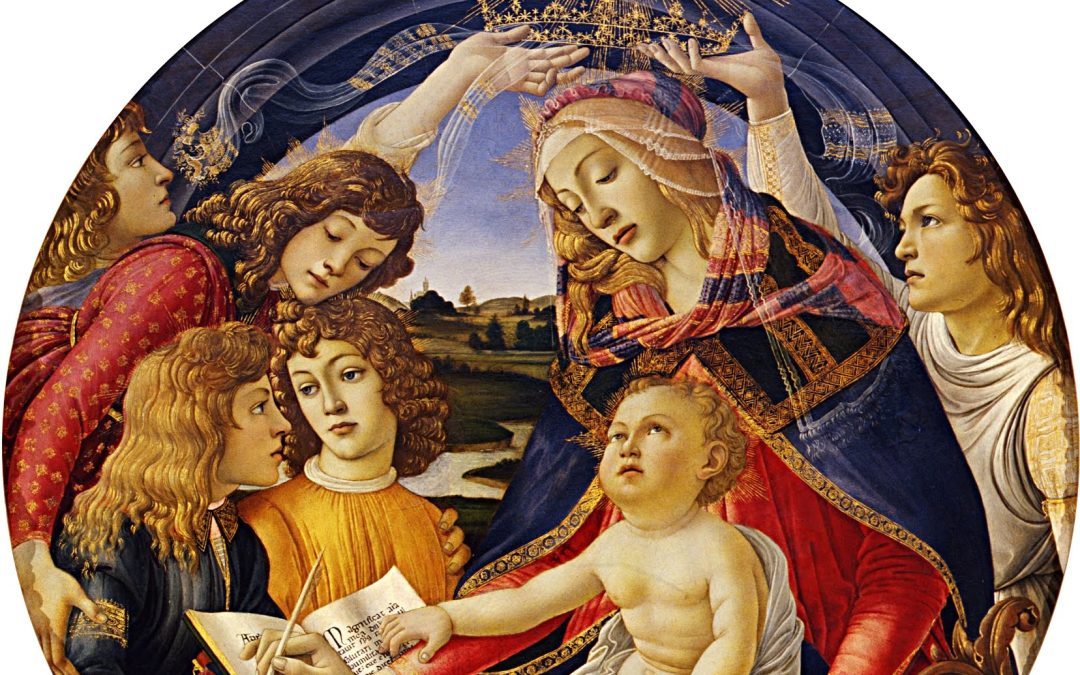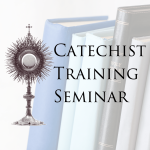During a recent trip back to Tyler, I was driving down Broadway Avenue with a non-Catholic friend when we spotted a bumper sticker that read: “No Mary, No Jesus. Know Mary, Know Jesus.” He didn’t know what to make of it, and I was soon flooded with all kinds of questions.
As our diocese celebrates the Year of Mary and the Eucharist, we will inevitably encounter many questions regarding Our Lady—and not just Protestants but from fellow Catholics, too. Just because one professes the Catholic Faith doesn’t necessarily mean that they know Catholic doctrine.
To help illustrate, imagine an average Catholic of goodwill. He doesn’t have a devotion to the Blessed Mother, but he isn’t necessarily opposed to it. He goes to Mass faithfully every Sunday and, as one interested in growing in his faith, sincerely wants to know whether or not Mary is “essential.” As far as he’s concerned, Marian devotion is fine for some, but he is unsure about her importance and asks, “As a Catholic, what must I believe about Mary?”
It’s an essential question. This article will attempt to answer it by first examining what it means to be a Catholic Christian, and then seeing what Mother Church teaches definitively about the Blessed Mother. Finally, we will arrive at an understanding of whether or not Mary is ancillary to the Catholic Faith, like a maraschino cherry on a sundae—a bonus, but not necessary—or if she is more like the ice cream.
Understanding the Deposit of Faith
To understand why a Catholic would be obligated to believe something, we must first consider what it means to be a Catholic. The word “catholic” is a combination of Greek words κατά (about) and ὅλος (whole), which the Catechism of the Catholic Church translates to “according to the totality” or “in keeping with the whole,” (CCC, 830) Understood in this sense, being a Catholic means we can’t take only the bits and pieces we like, as if one were at a buffet. We either take or leave everything.
In practice, this means accepting the perennial teachings of the Church contained in the depositum fidei (Sacred deposit of faith) as revealed by Christ and given to the Apostles, and handed down to their successors throughout the ages. Sacred Tradition, Sacred Scripture, and the Magisterium make up this deposit. We can think of these as the three legs of a stool. Keeping that image in mind, the Second Vatican Council’s Dogmatic Constitution on Divine Revelation, Dei Verbum, says, “one of them cannot stand without the others.” (Dei Verbum, 10) As we explore Marian doctrine, we will look to this single deposit to see what the Church infallibly teaches.
Dogma and Doctrine – What’s the Difference?
Some of the doctrines contained in the deposit of faith are dogmas. A dogma is a truth proclaimed by the Church to which the Christian owes “an irrevocable adherence of faith.” (CCC, 88) In other words, dogma is not up for debate; it is something a Catholic must believe. Dogmas are essential. They serve as “lights along the path of faith; they illuminate it and make it secure.” (CCC, 89) Without them, we wouldn’t know what to believe; we would be left in darkness and in error.
That said, not everything in the deposit of faith, nor everything a Catholic believes about the Blessed Mother, is dogma. We must also bear in mind that, “in Catholic doctrine there exists a ‘hierarchy’ of truths, since they vary in their relation to the fundamental Christian faith.” (CCC, 90) Simply put, some truths of the Faith are more important than others. This applies to Marian doctrine as well; some teachings are dogma, but other truths exist lower in the hierarchy and therefore do not require the same assent of faith.
The Four Marian Dogmas
With that clear, let’s return to the question posed earlier: what must a Catholic believe about the Blessed Virgin Mary? There are four Marian dogmas: Mary’s Divine Motherhood, Immaculate Conception, Perpetual Virginity, and Bodily Assumption. Holy Mother Church says that these are divinely revealed truths to which the faithful must adhere.
Before diving into each dogma individually, it’s natural for one to ask how it is that the Church pronounces these four Marian dogmas, especially here in East Texas where many of our dialogue partners will be approaching the issue and weighing our evidence from a sola scriptura perspective. I find the following paragraph of the Catechism critical: “What the Catholic faith believes about Mary is based on what it believes about Christ, and what it teaches about Mary illumines in turn its faith in Christ.” (CCC, 487) Even in the structure of the Catechism we see this: in order to find the teachings on Mary, one must look in the Christology section. What we know about Mary is informed by what we know of our Lord Jesus Christ from Scripture and Tradition, and as taught by the Magisterium.
Divine Motherhood: Mary is the Mother of God
The first Marian dogma to be promulgated is that of Mary’s Divine Motherhood. The Council of Ephesus said in AD 431: “If anyone does not confess that the Emmanuel (Christ) in truth is God and that on this account the Holy Virgin is the Mother of God (Θεοφόρος) since according to the flesh she brought forth the Word of God made flesh, let him be anathema.”1
The council bestowed upon Mary the Greek title Theotokos, which translates into English as “God-bearer.” To understand this dogma, it helps to refer back to the Catechism, paragraph 487, to reiterate that our Catholic understanding of Mary is formed by what we know about Christ. All Christians profess Jesus Christ to be the Divine Second Person of the Holy Trinity: Jesus is God. Mary is the mother of Jesus. Therefore, it logically follows that “as the Mother of the Son of God, Mary is the Mother of God.”2
The Immaculate Conception: Mary is Without Original Sin
The dogma of the Immaculate Conception refers to the conception of Mary without the stain of original sin. Pope Pius IX’s Ineffabilis Deus solemnly defined this teaching on December 8, 1854. We read the following from the apostolic constitution:
We declare, pronounce, and define that the doctrine which holds that the most Blessed Virgin Mary, in the first instance of her conception, by a singular grace and privilege granted by Almighty God, in view of the merits of Jesus Christ, the Savior of the human race, was preserved free from all stain of original sin, is a doctrine revealed by God and therefore to be believed firmly and constantly by all the faithful.
This infallible pronouncement by Pius IX dogmatized what was already a widely-held belief by the faithful since the early Church—a textbook example of the sensus fidelium, that is, the “supernatural appreciation of faith” possessed by the whole body of the faithful. (CCC, 92) With this unique and singular grace given to Mary, God “stacked the deck” for her particular vocation to be the mother of our Lord Jesus Christ.
Sacred Scripture does not explicitly reveal the Immaculate Conception. It is, however, understood to be implicit in the Protoevangelium (Gen. 3:15) and the Angelic Salutation and Elizabeth’s greeting to Mary in St. Luke’s Gospel.3
Perpetual Virginity: Before, During and After the Birth of Jesus
The dogma of Mary’s Perpetual Virginity maintains that Our Lady was a virgin ante partum, in partu, et post partum (before, during, and after the birth) of Jesus. Scriptural accounts of Sts. Matthew and Luke inform us that a virgin named Mary conceived and bore a child Jesus by the Holy Spirit. The virgin birth was believed by the earliest Christians and professed up and down the centuries in the various creeds of the Church. Since the Scriptural accounts directly attest to this truth, no Christian—Protestants included—questions the virgin birth.
The part that meets resistance is the Catholic understanding that Mary also remained a virgin her entire life. There was some disagreement over this belief among the early Church Fathers, although it was held by many, such as Origen, St. Ambrose, and St. Augustine.4 The Second Council of Constantinople in 553 defined the dogma and settled the matter once and for all by bestowing upon Mary the title Aeiparthenos, or, Perpetual Virgin.
Mary remaining a virgin during the birth of Jesus simply means that her physical integrity and purity remained intact: Mary did not suffer harm to her body when giving birth. As put by the Church Fathers, the miraculous virgin birth was like light passing through glass. In Lumen Gentium we read that Jesus’ birth “did not diminish his mother’s virginal integrity but sanctified it.” (Lumen Gentium, 57)
The Assumption: Mary was Assumed Body and Soul into Heaven
The most recent Marian dogma is the Assumption, promulgated in 1950, by Pope Pius XII in his apostolic constitution Munificentissimus Deus: “We proclaim and define it to be a dogma revealed by God that the immaculate Mother of God, Mary ever virgin, when the course of her earthly life was finished, was taken up body and soul into the glory of heaven.”5
We can understand this belief by considering the entirety of Mary’s life and in light of the dogmas previously expounded upon. Free from sin, graced with divine motherhood, and bodily pure and entirely for the God-man, Mary is uniquely elevated above all other creatures. It’s fitting that, at the end of her life, she would not be subject to the same bodily corruption as everyone else.
There remains some debate as to whether or not Mary first died a normal human death. The Eastern Churches celebrate the Dormition of the Mother of God, the “falling asleep” of Mary before her Assumption. However, what is important—and what must be believed—is that Mary was assumed, body and soul, into heaven to be at the right hand of her Divine Son, our Lord Jesus Christ.
Devotion to the Blessed Mother
Mary’s essential role in Christianity is made clear by the dogmas of her Divine Motherhood, Immaculate Conception, Perpetual Virginity, and Bodily Assumption. To our friend who wants to know the minimum he must believe about Mary, it is those four things. And from even a cursory glance at these dogmas, it should be abundantly clear that we need Mary. (She is like the ice cream, not the unnecessary cherry, of a sundae.)
But, let’s not forget about the equally-essential second piece of the bumper sticker that read: “No Mary, No Jesus. Know Mary, Know Jesus.” If we are merely giving our assent of faith, then we risk missing out on getting to know Mary—and to know Christ through her. Our knowledge of Our Lady is informed by what we know of our Lord. And knowledge and love of her is a sure way to increase our knowledge and love of him. Authentic devotion to Mary will only bring us closer to Jesus. As faithful Catholics, we must believe the dogma, but we shouldn’t stop there. Instead, let us take to heart the words of St. Louis de Montfort: “The more we honor the Blessed Virgin, the more we honor Jesus Christ, because we honor Mary only that we may the more perfect honor Jesus.”
Endnotes
1. Ott, Fundamentals of Catholic Dogma, 212 citing Denzinger-Huenermann 252.
2. Ibid.
3. Ibid., 216.
4. Ibid., 2245.
5. Ibid., 225.



